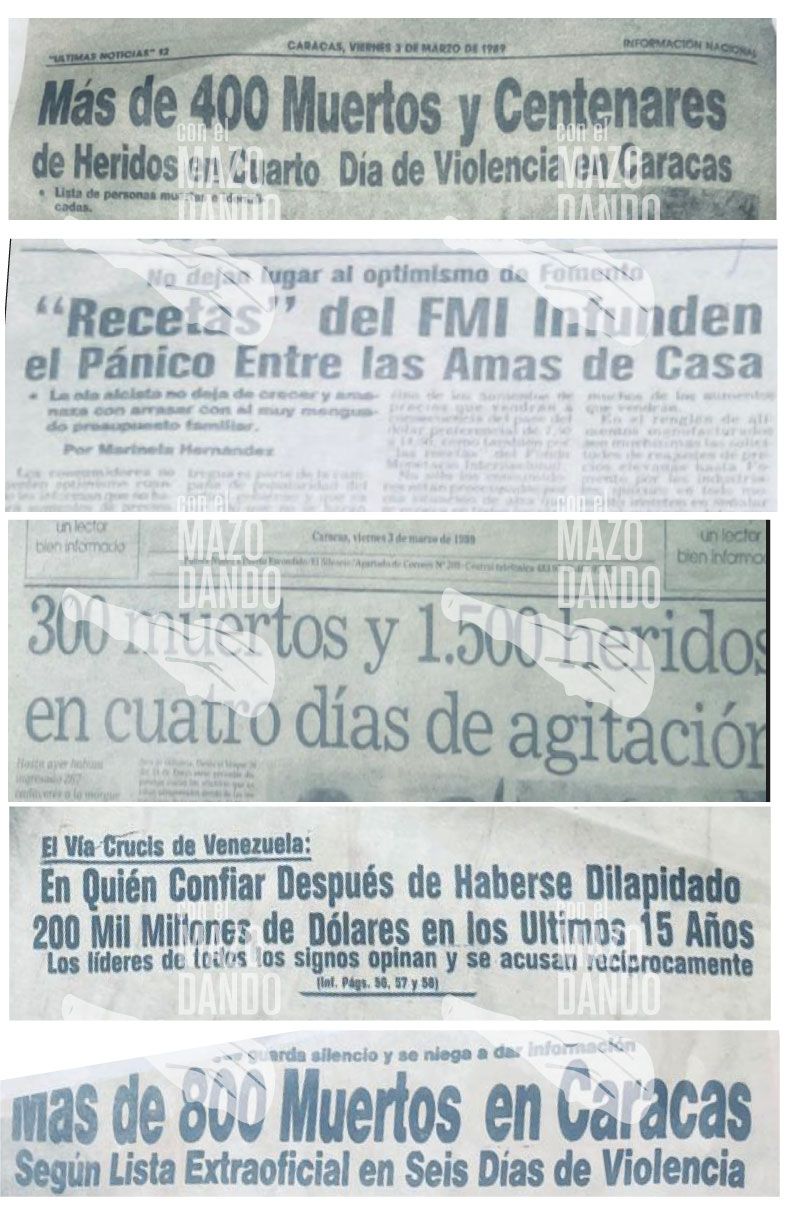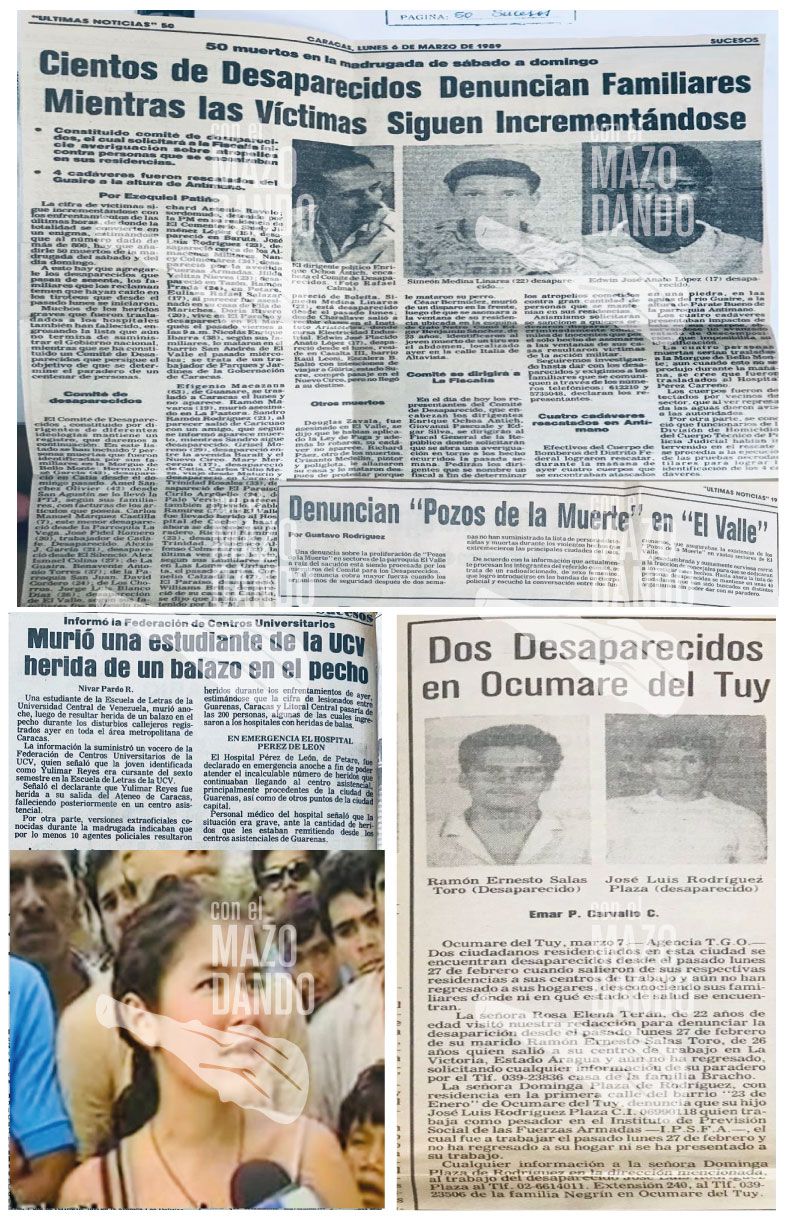“EL CARACAZO” More than 3,600 killed, thousands injured and hundreds missing
Published at: 06/03/2025 05:00 PM
(Latest News and EL NACIONAL, February 27 to March 11 1989/SIC Magazine No. 513-April 1989)
- On Wednesday, March 1, 1989, the main hospitals in Caracas, Guarenas, Los Teques and La Guaira received an avalanche of injuries and deaths outside their emergency rooms, at the rate of one person being shot per minute.
- It is estimated that 14,440 victims were admitted to these health centers with serious or fatal injuries.
- The massacre and “combing” of neighborhoods by agents of the General Sectorial Directorate of Intelligence and Prevention (DISIP), the National Guard, metropolitan police and military personnel continued with the same intensity until March 10.
- Many of the people were admitted to these hospitals with their brain mass, intestines and viscera outside, so they couldn't survive, despite medical efforts to save their lives.
- Guarenas was the starting point of this popular uprising against the package of neoliberal measures imposed by the International Monetary Fund (IMF).
- This “social shock” spread to Caracas and then to the states of La Guaira, Carabobo, Aragua, Lara, Bolívar, Mérida, Nueva Esparta and Zulia. In all these entities, there were deaths and injuries caused by State security forces
- For 31 years, Acción Democrática and Copei built up a veritable factory of poverty in Venezuela. To untangle it, the popular masses chose to exercise the overwhelming moral force of their overwhelming mobilization.
- To stop it, Carlos Andrés Pérez authorized the use of weapons of war against a huge unarmed population that went out to look for food that was scarce.
- Between February 27 and March 11, 1989, the Caracas morgues were oversaturated with corpses. The capital's more than 20 funeral homes reported 90 daily services (1,800), until the polls ran out.
- The government then set up the mass grave, misnamed “The Plague”, in the General Cemetery of the South, to which an even larger number of unidentified people were transferred, who, due to their advanced state of decomposition, could not wait for forensic medical expertise.
- All this, while taking into account the large number of victims who entered the statistics in Guarenas, Los Teques, La Guaira, Maracaibo, Valencia, Barquisimeto, San Félix, Puerto Ordaz, Mérida, Porlamar, San Cristóbal and Ciudad Bolívar.
- Ten days after February 27 and 28, the government was still killing people.
- Within the police forces, a repressive dynamic of searches, arbitrary arrests, humiliation of people and even rapacious appropriation of property and money found in their homes broke out.
- The operation to rescue goods taken from commercial establishments became, in many cases, an act of annihilation and police abuse by officials.
- In this phase, the metropolitan police, amidst exhaustion and perplexity, overwhelmed by the situation, shot left and right, with a strong dose of destructive violence.
- The agents of the General Sectorial Directorate of Intelligence and Prevention (DISIP) took advantage of the situation to hunt down several people identified as subversives and annihilate them.
- With the guarantees suspended, the Metropolitan Police (PM) and the DISIP acted with the greatest possible margin of abuse, leading to serious crimes against humanity.
- The Venezuelan people took to the streets, regardless of class distinction, and expressed themselves in the only language left to them by the ruling elites: social upheaval.
- To the violence of the economic measures that were exercised against the People, with the excuse of the “necessary” macroeconomic adjustments, they reacted with a genuinely necessary explosion, the magnitude of which was due to the demand of Social Justice.

What happened? :
- Once again the People were the protagonist of the story, in the events that occurred between February and March 1989. The first phase of this social explosion was massive.
- Against the hoarding of products, the people took to the streets penetrating supplies and supermarkets, finding in their warehouses the products that their owners hoarded for previous weeks, waiting for prices to rise.
- It all happened while in New York, Miguel Rodríguez and Pedro Tinoco were signing a memorandum of understanding with the International Monetary Fund (IMF), as part of a time bomb that was installed because of this situation of structural injustice.
- The fuse for the explosion was set by the government of Carlos Andrés Pérez and ignited with the announcements made before the inauguration. The immense contradiction between the call to sacrifice of the majority and the ostentation of their act of “coronation” was evident.
- The hoarding of merchants, waiting to increase prices, boosted the first phase of the popular masses, trapping day and night the products that were normally inaccessible to them.
- Some small merchants opened their doors on their own initiative so that people could take their food without destroying the place and, if they were esteemed by the people, for their honesty and supportive attitude, they were respected.
- In the explosion, there was a clear message from the People to the ruling classes, who forgot about people using it as a manipulable object when it came to their electoral campaigns.
- Representative democracy, inaugurated in 1958, was characterized precisely because it was founded precisely on a pact between economic, political, religious and military elites. The Venezuelan people were more an object than a subject of rights. Until the differences in the distribution of wealth became scandalous and desperate people, due to shortages and hunger, took to the streets.
- During the third phase of this popular rebellion, the government of Carlos Andrés Pérez decreed a “State of siege”, and the Minister of Internal Relations, Alejandro Izaguirre, suffered an apparent collapse in front of the cameras, handing over responsibility for the massacre to the Armed Forces and police forces.
- The political status quo, the business elites, the senior clergy and some generals were carried away by the conviction that the country was willing to sign a blank letter for any measure taken by the newly elected president. It wasn't like that.

Mazo News Team